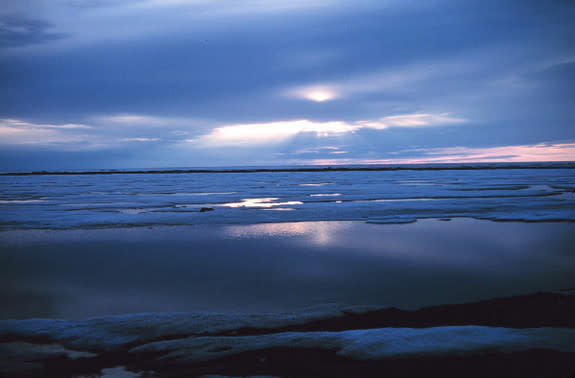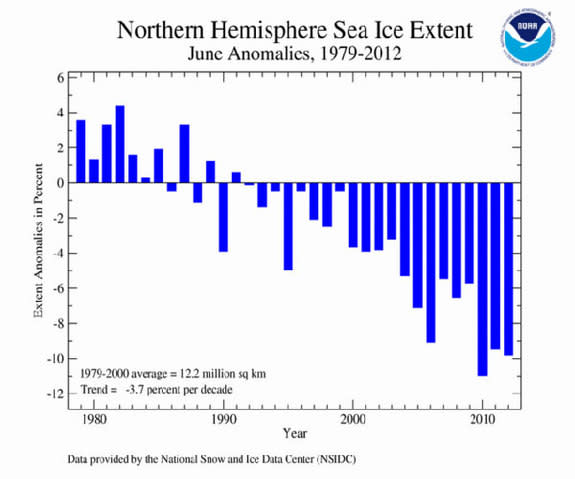June Arctic Ice Melt Sets Records
Last month, Arctic sea ice reached its second-lowest extent and the largest ice melt on record for the month of June since 1979. At 4.24 million square miles, (10.97 million square kilometers), the ice cap over the northern tip of the planet was nearly 10 percent below the average extent, according to satellite measurements.
Arctic sea ice, which plays an important role in global climate, grows and shrinks in an annual cycle, reaching its annual minimum every September before building back up to cover the ocean during the winter months.
An unusually low extent early in summer, as happened in June, does not portend a record low in September. A number of factors, including winds and the cloud cover, influence the rate of melt over the summer, so it's not possible to predict how much ice will remain at the low in September, Walt Meier, a research scientist at the U.S. National Snow and Ice Data Center (NSIDC), which tracks the ice, told LiveScience in June.
Recent years have brought unprecedented lows to Arctic sea ice. According to NSIDC records, September 2007 saw the all-time low, while a German group based at the University of Bremen used different data to conclude that September 2011 brought the lowest extent on record.
The large melt this past June happened because cold Arctic temperatures helped the ice extent grow during February and March 2012 to a relatively high level reminiscent of the 1980s or 1990s, said Josefino Comiso, a senior scientist at NASA's Goddard Space Flight Center.
But during June, much of this growth disappeared. This is a sign that the thicker, perennial ice that survives year after year in the Arctic is unlikely to recover significantly from the 2011 record or near-record low, Comiso said.
Scientists blame receding sea ice on a combination of natural weather fluctuations and global warming. This year is shaping up to be a warm one. Last month also ranked as the fourth-warmest June globally, and ushered in the warmest 12-month period for the lower 48 United States since record keeping began in the late 19th century.
A low extent in June is significant because it coincides with the summer solstice, the time when the Arctic receives the most sunlight. While white ice reflects sunlight, dark water absorbs the warmth and stores it, resulting in more melting later on. More exposed water means more stored heat and, ultimately, more melting, Meier explained.
Likewise, the change in reflectivity, called albedo, has the potential to aggravate the warming of the planet, because a decline in Arctic sea ice means more warmth is absorbed into the oceans, rather than being reflected back out into space. This has implications for global weather patterns.
The loss of sea ice also affects animals, including walrus and polar bears, which depend on it.
While Arctic sea ice has been in decline in recent years, the same is not true of the Antarctic sea ice, which forms around the southernmost continent. The Antarctic sea ice has shown a small, though not statistically significant, trend toward larger extents, according to the NSIDC.
In June, during the southern winter, Antarctic sea ice was more than 2 percent above average, ranking as the tenth-largest extent on record since 1979. Research indicates these small increases are a result of changes in weather patterns produced by the ozone hole over the Antarctic.
Follow Wynne Parry on Twitter @Wynne_ParryorLiveScience @livescience. We're also on Facebook & Google+.
Copyright 2012 LiveScience, a TechMediaNetwork company. All rights reserved. This material may not be published, broadcast, rewritten or redistributed.



